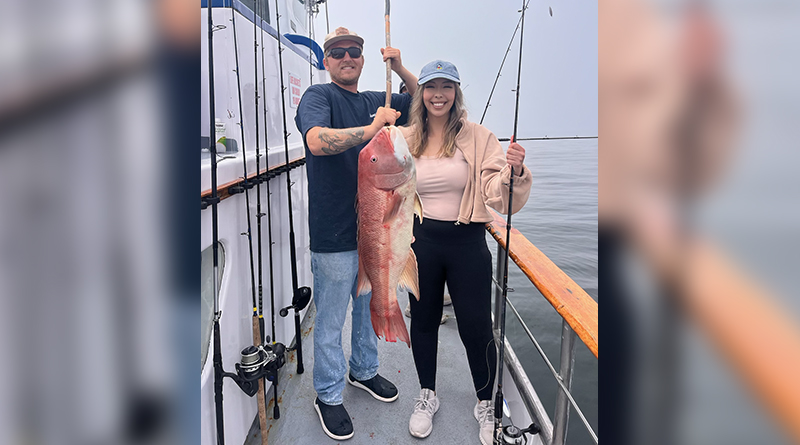Have you ever seen a female sheephead tip the scales near 9 pounds? If you’re a regular on the boats off Southern California, you’ll know that’s no small feat — literally. While California sheephead are common targets for anglers aboard local half-day boats, it’s not every day you see a female hauled over the rail with that kind of weight. And when one does show up? It turns heads — and drops a few jaws.
Just ask the crew aboard the Clemente out of Dana Wharf Sportfishing. Earlier this month, they shared a post on their Facebook page spotlighting a stunning sheephead caught during a half-day trip. “Here’s a nice 1/2 day sheephead taken aboard the Clemente yesterday. This beautiful fish went almost 9lbs,” the post read. Even better? The fish was caught by a female angler — proving the growing presence of female anglers who are making memorable catches.
This fish is in fact a female, based on its overall coloring, but is lacking the more natural streamlined head shape that females have compared to the males who have a more robust and bulbous forehead (for lack of better words). This subtle features hinted that it may have been teetering on the edge of transition — a biological process that makes the species all the more fascinating.
All California sheephead are born female, and as they grow and mature, some undergo a natural sex change, becoming male. This evolutionary strategy, known as sequential protogynous hermaphroditism, is not just a biological quirk — it’s a key survival and reproductive strategy. In sheephead communities, one dominant male will often control mating access to a group of females. If he’s removed — by fishing or natural causes — the largest, most dominant female will transition into a male to take over his role. Smaller fish reproduce more efficiently as females. Once large enough to defend territory and attract mates, they shift to male to maximize their lifetime reproductive output, following what’s called the size-advantage model. Overfishing of large males can also skew sex ratios, prompting more females to change earlier than they might otherwise. This can lead to long-term ecological impacts on the population.
California sheephead are among the most visually distinct reef species off the Pacific coast, and it’s easy to tell males from females once you know what to look for. Females have a pinkish to reddish body, a white underside, and a slimmer, rounded head. They typically max out around 14 to 16 inches before transitioning. Males, on the other hand, sport a black head and tail, a red-orange midsection, and develop a prominent bulbous forehead, called a nuchal hump. Their teeth and jaw power also increase with size, allowing larger males to crush urchins, crabs, and mollusks with ease.
According to a Draft Marine Species Report on Sheephead posted by opc.ca.gov, female sheephead generally reach 14.5 inches before changing sex. Yet there’s a historic record of a 30-year-old female weighing 18.3 pounds — a massive outlier for the species. “Individual growth of fishes is quite variable, not only among different groups of species, but also within the same species,” the report notes. In the day-to-day fishing world, however, female sheephead in the 4- to 5-pound range are more typical — and still draw plenty of “oohs” and “ahhs” from fellow anglers. As one frequent angler shared, “Every female sheephead I’ve seen pulled up is about 5 pounds, and that’s one that gets a lot of attention when you bring it over the rail.”
Understanding the lifecycle and physical markers of California sheephead is more than just trivia for biologists — it’s also useful for anglers, conservationists, and anyone with an interest in marine science. With increasing awareness around sustainable fishing practices, it’s important to appreciate the role these unique fish play in their rocky reef ecosystems and how human activity influences their populations.
A big shout-out to Dana Wharf Sportfishing and the crew aboard the Clemente for their consistent work connecting anglers with memorable moments like this one. Whether it’s a first-time fisher or a seasoned local, there’s always something awe-inspiring about pulling in a fish that defies expectations.
Next time you’re out on the water and a sheephead comes over the rail — take a closer look. You might just be witnessing the start (or end) of an incredible transformation. And if you ever happen to land a female over 9 pounds? Snap a photo, show it off, and maybe even send it our way. Because sometimes, “you go girl” isn’t just a cheer — it’s a celebration of skill, strength, and one unforgettable catch.





